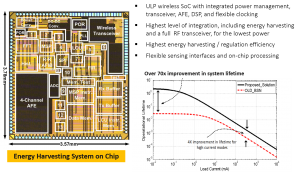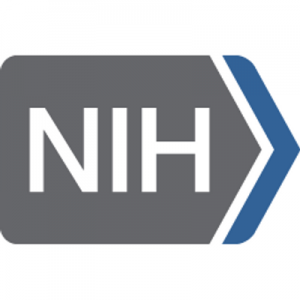 Internet-of-things (IoT) is an umbrella term being used to describe everyday objects that are made ”smart” with the integration of electronics and are connected to a network to receive and send data. The broad defining feature of an IoT device includes sensing to extract usable information and communicating this information to a remotely located user. This concept of IoT promises an exponential growth in the number of connected devices both in the consumer space as well as in the industrial space. A positive trend in this direction is already being seen in recent years. However, the true potential of IoT can only be realized if they are made self-sustainable. A key requirement towards achieving self-sustainability is the ability of IoT devices to be self-powered. It is estimated that 274M battery replacement would be needed every day even if trillions of IoTs are powered by batteries that last for 10 years. This is a significant maintenance cost which underlines the clear need for developing battery-less IoT devices. We developed circuit design techniques that can increase the lifetime of an IoT device by 4X to 70X. We increase the lifetime by providing more energy through efficient and low voltage energy harvesting. We also reduce the power consumption of the IoT through ultra-low power circuits and low voltage operation. The combined effect of energy harvesting, ultra-low power consumption, and low voltage operation increases the lifetime by making more energy available on one hand while reducing the power consumption on the other.
Internet-of-things (IoT) is an umbrella term being used to describe everyday objects that are made ”smart” with the integration of electronics and are connected to a network to receive and send data. The broad defining feature of an IoT device includes sensing to extract usable information and communicating this information to a remotely located user. This concept of IoT promises an exponential growth in the number of connected devices both in the consumer space as well as in the industrial space. A positive trend in this direction is already being seen in recent years. However, the true potential of IoT can only be realized if they are made self-sustainable. A key requirement towards achieving self-sustainability is the ability of IoT devices to be self-powered. It is estimated that 274M battery replacement would be needed every day even if trillions of IoTs are powered by batteries that last for 10 years. This is a significant maintenance cost which underlines the clear need for developing battery-less IoT devices. We developed circuit design techniques that can increase the lifetime of an IoT device by 4X to 70X. We increase the lifetime by providing more energy through efficient and low voltage energy harvesting. We also reduce the power consumption of the IoT through ultra-low power circuits and low voltage operation. The combined effect of energy harvesting, ultra-low power consumption, and low voltage operation increases the lifetime by making more energy available on one hand while reducing the power consumption on the other.
The project is funded through the generous support from NIH.
Related Publication
- N. Zaeimbashi, H. Lin, C. Dong, X. Liang, M. Nasrollahpour, N. Sun, A. Matyushov, Y. He, X. Wang, C. Tu, Y. Wei, Y. Zhang, S. Cash, M. Monabjo, A. Shrivastava, and N. X. Sun, “NanoNeuroRFID: A Wireless Implantable Device Based on Magnetoelectric Antennas”, IEEE Journal of Electromagnetics, RF and Microwaves in Medicine and Biology. vol. 3 issue 3, pp. 206-215, 09/2019. pdf
- N. Shafiee, S. Tewari, B. H. Calhoun and A. Shrivastava , “Infrastructure Circuits for Lifetime Improvement of Ultra-Low Power IoT Devices”, IEEE Transactions on Circuits and Systems-I (TCAS-I). Sept-2017. pdf
- N. E. Roberts, K. Craig, A. Shrivastava, S. N. Wooters, Y. Shakhsheer, B. H. Calhoun, and D. D. Wentzloff, “A 236nW -56.5dBm Sensitivity Self-Powered Bluetooth Low-Energy Wakeup Receiver in 65nm CMOS“, IEEE International Solid-State Circuits Conference (ISSCC), 2016. pdf
- A. Roy , A. Klinefelter, F. Yahya, X. Chen, P. Gonzalez, C. J. Lukas, D. Akella, J. Boley, K. Craig, M. Faisal, et al., “A 6.45μW Self-Powered SoC with Integrated Energy-Harvesting Power Management and ULP Asymmetric Radios for Portable Biomedical Systems“, IEEE Transactions on Biomedical Circuits and Systems, vol. 9, issue 6, pp. 862-874, 12/2015. pdf
- “A 6.45 μW Self-Powered IoT SoC with Integrated Energy-Harvesting Power Management and ULP Asymmetric Radios“, IEEE International Solid-State Circuits Conference (ISSCC), San Francisco, CA, IEEE, 02/2015. pdf
- “Ultra Low Power Circuits and Systems for Self-Powered Wireless Sensors”, GOMACTech, 2015.
- Y. Zhang, F. Zhang, Y. Shakhsheer, J. D. Silver, A. Klinefelter, M. Nagaraju, J. Boley, J. Pandey, A. Shrivastava, E. J. Carlson, Austin Wood, Benton H. Calhoun, Brian P. Otis, “A Batteryless 19 µW MICS/ISM-Band Energy Harvesting Body Sensor Node SoC for ExG Applications“, IEEE Journal of Solid-State Circuits (JSSC), Vol. 48, No. 1, January 2013, pgs. 199-213. pdf
- F. Zhang, Y. Zhang, J. Silver, Y. Shakhsheer, M. Nagaraju, A. Klinefelter, J. Pandey, J. Boley, E. Carlson, A. Shrivastava, B. Otis, B. H. Calhoun, “A Batteryless 19µW MICS/ISM-Band Energy Harvesting Body Area Sensor Node SoC” IEEE Solid-State Circuits Conference (ISSCC), February 2012. pdf
